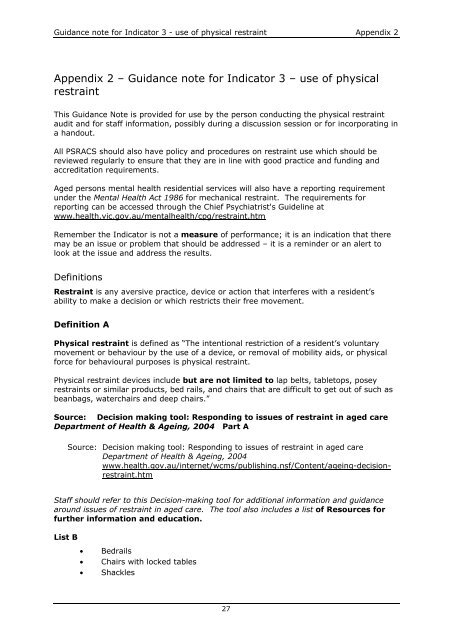Resource Manual For Quality Indicators In - Department of Health
Resource Manual For Quality Indicators In - Department of Health
Resource Manual For Quality Indicators In - Department of Health
You also want an ePaper? Increase the reach of your titles
YUMPU automatically turns print PDFs into web optimized ePapers that Google loves.
Guidance note for <strong>In</strong>dicator 3 - use <strong>of</strong> physical restraint Appendix 2<br />
Appendix 2 – Guidance note for <strong>In</strong>dicator 3 – use <strong>of</strong> physical<br />
restraint<br />
This Guidance Note is provided for use by the person conducting the physical restraint<br />
audit and for staff information, possibly during a discussion session or for incorporating in<br />
a handout.<br />
All PSRACS should also have policy and procedures on restraint use which should be<br />
reviewed regularly to ensure that they are in line with good practice and funding and<br />
accreditation requirements.<br />
Aged persons mental health residential services will also have a reporting requirement<br />
under the Mental <strong>Health</strong> Act 1986 for mechanical restraint. The requirements for<br />
reporting can be accessed through the Chief Psychiatrist's Guideline at<br />
www.health.vic.gov.au/mentalhealth/cpg/restraint.htm<br />
Remember the <strong>In</strong>dicator is not a measure <strong>of</strong> performance; it is an indication that there<br />
may be an issue or problem that should be addressed – it is a reminder or an alert to<br />
look at the issue and address the results.<br />
Definitions<br />
Restraint is any aversive practice, device or action that interferes with a resident’s<br />
ability to make a decision or which restricts their free movement.<br />
Definition A<br />
Physical restraint is defined as “The intentional restriction <strong>of</strong> a resident’s voluntary<br />
movement or behaviour by the use <strong>of</strong> a device, or removal <strong>of</strong> mobility aids, or physical<br />
force for behavioural purposes is physical restraint.<br />
Physical restraint devices include but are not limited to lap belts, tabletops, posey<br />
restraints or similar products, bed rails, and chairs that are difficult to get out <strong>of</strong> such as<br />
beanbags, waterchairs and deep chairs.”<br />
Source: Decision making tool: Responding to issues <strong>of</strong> restraint in aged care<br />
<strong>Department</strong> <strong>of</strong> <strong>Health</strong> & Ageing, 2004 Part A<br />
Source: Decision making tool: Responding to issues <strong>of</strong> restraint in aged care<br />
<strong>Department</strong> <strong>of</strong> <strong>Health</strong> & Ageing, 2004<br />
www.health.gov.au/internet/wcms/publishing.nsf/Content/ageing-decisionrestraint.htm<br />
Staff should refer to this Decision-making tool for additional information and guidance<br />
around issues <strong>of</strong> restraint in aged care. The tool also includes a list <strong>of</strong> <strong>Resource</strong>s for<br />
further information and education.<br />
List B<br />
• Bedrails<br />
• Chairs with locked tables<br />
• Shackles<br />
27
















